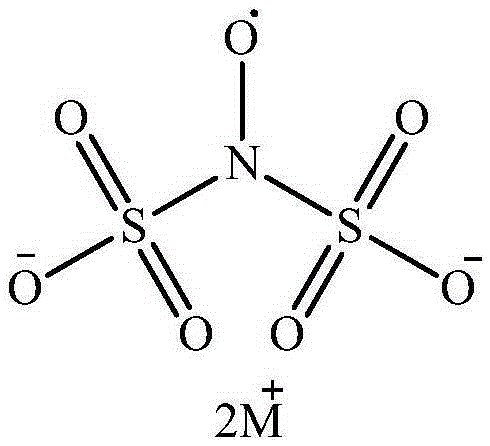A method for measuring carbon-centered free radicals
A method of determination and technology of free radicals, applied in the preparation of test samples, measurement of color/spectral characteristics, etc., can solve the problems of high reactivity, short life, low concentration, etc., achieve high sensitivity, simple equipment, and low detection cost low effect
- Summary
- Abstract
- Description
- Claims
- Application Information
AI Technical Summary
Problems solved by technology
Method used
Image
Examples
Embodiment 1
[0057] (1) Preparation of the solution to be tested
[0058] Using hydrochloric acid-sodium citrate buffer solution with pH=4 as solvent, prepare potassium nitrosodisulfate solution I with a concentration of 7 mmol / L.
[0059] Using the above buffer solution as a solvent, prepare azobisisobutylamidine hydrochloride initiator solution II with a concentration of 42 mmol / L.
[0060] Using the above buffer solution as a solvent, prepare potassium nitrosodisulfate and initiator mixed solution III, wherein the concentration of potassium nitrosodisulfate is the same as that in solution I, and the concentration of initiator is the same as that in solution II.
[0061] Potassium nitrosodisulfate solution Ⅰ is used to determine the parameters in the fitting formula 1; potassium nitrosodisulfate and initiator mixed solution Ⅲ is used to measure and calculate the concentration of carbon center free radicals and the accumulated carbon center in the system at a certain moment free radical ...
Embodiment 2
[0071] (1) Preparation of the solution to be tested
[0072] Na at pH=7.1 2 HPO 4 -K 2 HPO 4 The buffer solution is used as the solvent, and the sodium nitrosodisulfate solution I with a concentration of 0.05mmol / L is prepared.
[0073] Using the above buffer solution as a solvent, prepare azobisisobutylimidazoline hydrochloride initiator solution II with a concentration of 0.1 mmol / L.
[0074] Using the above buffer solution as a solvent, prepare the mixed solution III of sodium nitrosodisulfate and initiator, wherein the concentration of sodium nitrosodisulfate is the same as that in solution I, and the concentration of initiator is the same as that in solution II.
[0075] Sodium nitrosodisulfate solution Ⅰ is used to determine the parameters in the fitting formula 1; sodium nitrosodisulfate and initiator mixed solution Ⅲ is used to measure and calculate the carbon center free radical concentration and the accumulated carbon center free radical concentration in the syst...
Embodiment 3
[0085] (1) Preparation of the solution to be tested
[0086] Na at pH=12 2 HPO 4 -NaOH buffer solution is used as solvent, and ammonium nitrosodisulfate solution I with a concentration of 20mmol / L is prepared.
[0087] Using the above buffer solution as a solvent, prepare azobiscyanovaleric acid initiator solution II with a concentration of 100 mmol / L.
[0088] Using the above buffer solution as a solvent, prepare a certain concentration of ammonium nitrosodisulfate and initiator mixed solution III, wherein the concentration of ammonium nitrosodisulfate is the same as that in I, and the concentration of the initiator is the same as in II.
[0089] Ammonium nitrosodisulfate solution I is used to determine the parameters in the fitting formula 1; ammonium nitrosodisulfate and initiator mixed solution III is used to measure and calculate the concentration of free radicals in the system at a certain moment and the cumulative concentration of free radicals.
[0090] (2) Test ste...
PUM
 Login to View More
Login to View More Abstract
Description
Claims
Application Information
 Login to View More
Login to View More - R&D
- Intellectual Property
- Life Sciences
- Materials
- Tech Scout
- Unparalleled Data Quality
- Higher Quality Content
- 60% Fewer Hallucinations
Browse by: Latest US Patents, China's latest patents, Technical Efficacy Thesaurus, Application Domain, Technology Topic, Popular Technical Reports.
© 2025 PatSnap. All rights reserved.Legal|Privacy policy|Modern Slavery Act Transparency Statement|Sitemap|About US| Contact US: help@patsnap.com



